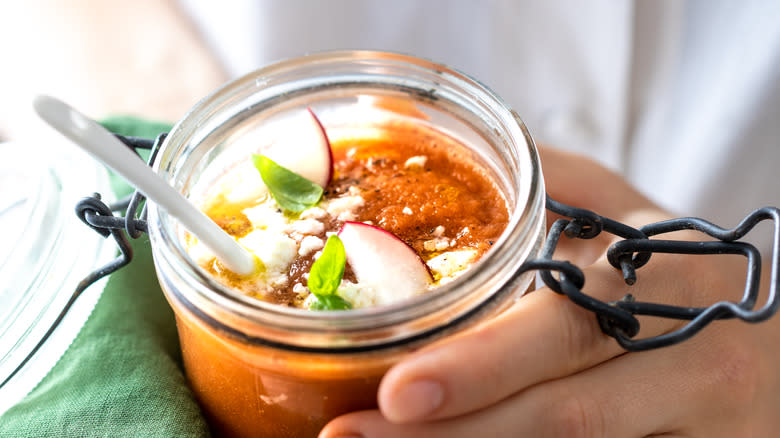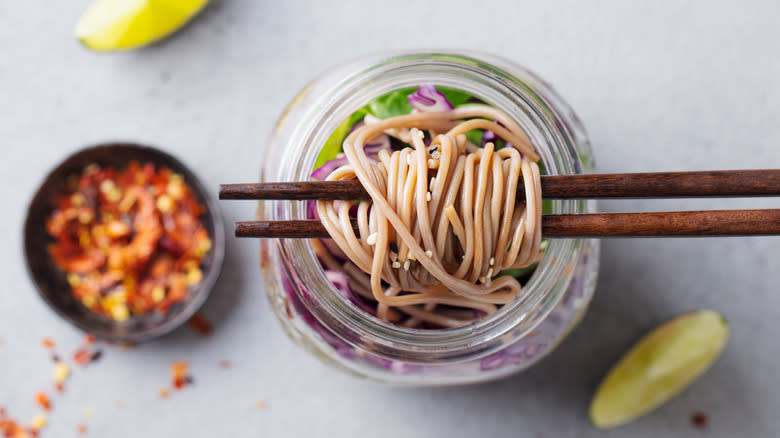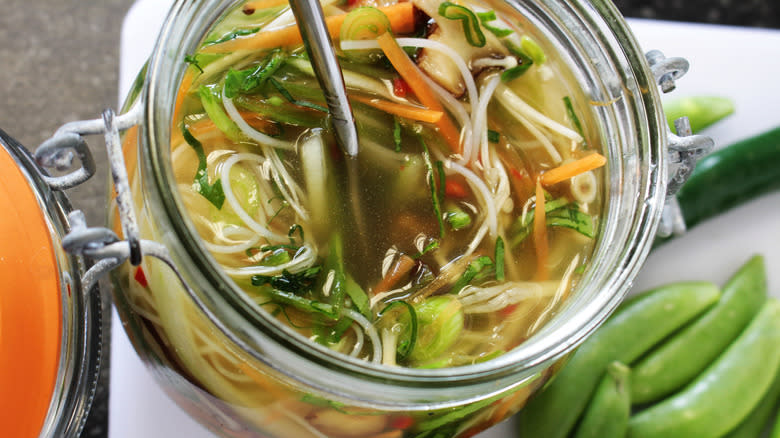A Mason Jar Is Your Secret Weapon For Effortless Make-Ahead Soups

Now that we're back in the office or at school, lunch on the go is a necessity again, so Sunday meal prep means assembling bowls and jars of colorful rice bowls and salads. But if soup is more your thing, then mason jar soups are a convenient way to enjoy the warmth and comfort of homemade soup on the go.
Right up there with mason jar salads, mason jar soups are visually appealing with bright, colorful ingredients layered to preserve freshness and flavor. You can make them as hearty or as light as you like, whether you need some fuel for the gym after work or a pick-me-up. They're quick to assemble with little preparation beforehand -- about as much as you would need for a grain bowl or salad jar. And you can do it with just about any soup recipe you enjoy, from miso ramen to barley soup. You just add water, wait five minutes, and enjoy.
Read more: Canned Soups You Should And Shouldn't Buy
Layering Your Ingredients Will Ensure Freshness

When you set out on your soup jar journey, think about the ingredients and how they'll play together both separate and in soup form. Much like a mason jar salad, layering is important for ingredient integrity, especially if you're assembling on Sunday and eating on a Wednesday. You don't want greens that are slimy or wilted because they were shoved under the weight of chunks of chicken breast.
Your mason jar should be clean and dry before you assemble your soup ingredients layer by layer. Your condiments and soup bases go on the bottom. This could include crushed bouillon cubes or bouillon paste, miso paste, chili sauce, chili crisp, grated ginger -- the limit is your imagination. You can even empty a ramen seasoning packet. Then, like mason jar salads, the heartiest ingredients go on the bottom, mixed in with your condiment base. Proteins like chicken and ground meat should be cooked first, as the boiling water will merely serve to heat things through. Tofu, drained and rinsed, canned beans, and other grains can go next, then your lighter ingredients. Your favorite veggies like bean sprouts, carrots, onions, or sliced mushrooms make a nice base for your noodle of choice. Top with soup greens like spinach or escarole so they don't get slimy.
Your garnishes -- like delicate cilantro leaves, pickled ginger, sliced scallions, grated parmesan, and lemon wedges -- can go in a small zip-top baggie or plastic box to be added after you add your boiling water.
Pre-Cook Some Ingredients

To ensure ingredients are just as delicious when you put them in the jar as when you eat them in soup form, there are a few tips and tricks. Your noodles should be par-cooked and tossed in oil, or you can track down noodles that cook in 60 seconds. Or, if they're an instant ramen or rice vermicelli noodle, broken into chunks that fit in the jar. The water doesn't stay hot long enough to cook a spaghetti noodle, so cook and cool those all the way before putting them in your jar. If you have harder veggies like carrots or Napa cabbage, you can give them a quick sauté or make sure they're shredded finely enough for the water to cook them through. If you want really low prep, you can use defrosted frozen veggies like corn and peas, which are precooked and will warm through in the boiling water. Because the ingredients are fresh, the jars shouldn't be kept in the fridge for longer than five days.
When you're ready to eat, make sure the mason jar is around room temperature, as pouring boiling water into a cold mason jar could lead it to crack or break. After pouring the water, give it a stir or a shake (with the lid on), and let it rest for five minutes before digging in.
Read the original article on Daily Meal.

